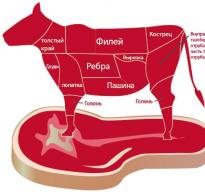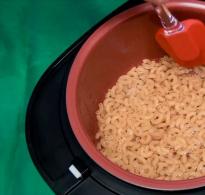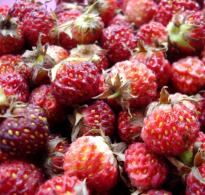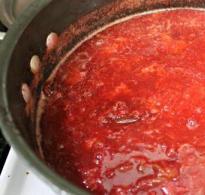Veterinary sanitary examination in full. Technology and hygiene of the production of canned meat
Veterinary and Sanitary Expertise (VSE) used for agricultural raw materials and food products of animal origin. The purpose this expertise is to ensure the safety of consumers by preventing them from contracting diseases common to humans and animals.
The tasks of the WSE:
® timely detection of dangerous infectious diseases, which can be carried by goods;
development and application of established methods of veterinary and sanitary assessment;
Confirmation of compliance of objects of examination with veterinary requirements.
Objects VSE are food, leather, fur and other raw materials, as well as food products of animal origin.
Food products of animal origin include dairy, meat, fish products, including aquatic organisms, eggs. In addition, as an exception, these facilities include non-industrial plant products sold in the markets. The assignment of such products to WSE facilities is explained by the need to control their safety and the possibility of such control in veterinary laboratories operating in the markets.
The veterinary and sanitary examination precedes the sanitary and epidemiological examination of food products. Only in the presence of veterinary certificates issued by the bodies of the Federal Service for Veterinary and Phytosanitary Surveillance in accordance with the established procedure, it is allowed to conduct a sanitary and epidemiological examination of food products.
The need to conduct a HSE is due to the following reasons:
the presence of dangerous diseases common to humans and animals (for example, foot and mouth disease, anthrax, etc.), and the need to protect the population from them;
The emergence of new, previously unknown diseases common to humans and animals (for example, “mad cow disease”, “bird flu”, etc.).
The use of vaccines and other animal protection products, as well as hormonal drugs to accelerate growth, which requires control over the use and content of their residual amounts that do not exceed the established norms; t the danger of wide spread of infectious and mass non-infectious animal diseases;
the need to ensure the safety of animal products in veterinary and sanitary terms;
protection of the territory of Russia from the introduction of infectious animal diseases from foreign countries;
The grounds for conducting the WSE are:
the receipt of animal products from regions or countries in which animal diseases dangerous to humans have been detected;
the absence of veterinary or commodity labeling on livestock products in accordance with the established requirements (for example, before the sale of meat carcasses on the market);
suspicion of veterinary and sanitary distress of livestock products during a comprehensive commodity examination;
testing for certification purposes.
VSE can be carried out independently (for example, in the markets) or be part of a comprehensive commodity examination. The organization and conduct of the WSE are determined by Art. 21 and 22 of the Law of the Russian Federation "On Veterinary Medicine", as well as veterinary rules issued in accordance with veterinary legislation.
According to the results of the veterinary and sanitary examination, livestock products must comply with the established safety requirements for public health and originate from territories free from contagious animal diseases.
The veterinary and sanitary examination can be carried out in full, and then the product, marked with the Oval veterinary stamp, is produced for food purposes without restrictions. Only a veterinary stamp is placed on the meat to be disinfected, indicating the procedure for using such meat in accordance with the current veterinary and sanitary and sanitary 0. epidemiological standards.
VSE can also be carried out by means of ante-mortem and post-mortem examination of animals (horses were examined for glanders during their lifetime). In this case, the meat is marked with a rectangular veterinary stamp with the inscription "Preliminary examination". Such branding does not give the right to sell meat in full.
Subjects of VSE. In accordance with the Law of the Russian Federation "On Veterinary Medicine", veterinary specialists with higher and secondary education have the right to engage in veterinary activities. This applies equally to the experts conducting the WSE. As such experts are employees of veterinary and veterinary-sanitary services, so it is advisable to consider the organization of veterinary services in the country (Fig. 23).
The Federal Service for Veterinary and Phytosanitary Supervision carries out veterinary and sanitary examination of animal products, other special measures aimed at protecting the population from diseases common to humans and animals, as well as from food poisoning arising from the use of animal products hazardous in veterinary and sanitary terms ( Article 20 of the Law of the Russian Federation “On Veterinary Medicine”).
The head of the Federal Service for Veterinary and Phytosanitary Supervision is the chief state veterinary inspector of the Russian Federation, and the heads of regional veterinary directorates (departments) are the chief state veterinary inspectors of the respective regions. The head of this Federal Service ex officio represents the Russian Federation in the International Epizootic Bureau, in the World Veterinary Association, and in other international organizations.
Subdivisions of the Federal Service for Veterinary and Phytosanitary Supervision are created at enterprises for the processing and storage of animal products (meat processing plants, slaughterhouses, distribution refrigerators, etc.). In addition, organizations (enterprises, institutions) at their own expense can create production veterinary services, which must carry out their activities under the methodological guidance of the chief state veterinary inspector of the Russian Federation.
Legal and regulatory frameworkWSE- a set of standards, technical conditions, rules, instructions that establish veterinary requirements that are mandatory for the conduct of animal husbandry, keeping animals, production, storage, transportation and sale of livestock products.
Rice. 23. System of the Federal Veterinary and Departmental Veterinary and Sanitary Service of the Russian Federation
The legal framework of the VSE is formed by the Law of the Russian Federation "On Veterinary Medicine", legislative acts developed on its basis, as well as instructions of the State Veterinary Service of Russia and sanitary rules. The veterinary legislation of the Russian Federation regulates relations in the field of veterinary medicine in order to protect animals from diseases, to release animal products that are safe in veterinary terms and to protect the population from diseases common to humans and animals.
The said Law regulates the organization of the veterinary service of Russia, state veterinary and departmental veterinary and sanitary supervision, as well as general requirements for the prevention and elimination of animal diseases and ensuring the safety of animal products in veterinary terms, protection of the population from diseases common to humans and animals, food poisoning , responsibility for violation of the veterinary legislation of the Russian Federation.
Organizations and citizens engaged in the procurement, processing, storage, transportation and sale of livestock products are obliged to ensure the fulfillment of these requirements (Articles 15, 18 of the Law "On Veterinary Medicine").
It is prohibited to sell and use for food purposes meat, meat products and other products of slaughter of animals, as well as milk, meat products, eggs, and other products that are not subject to the HSE in accordance with the established procedure.
The procedure for processing and using leather, fur and other raw materials of animal origin is determined by the current veterinary and sanitary rules.
The sale and use of these types of raw materials and products for food and non-food purposes that do not meet veterinary requirements entails the imposition of fines: on citizens - in the amount of five times the minimum wage established by law, on officials - up to ten times its size.
Only healthy animals are allowed to be imported into Russia, as well as animal products obtained from healthy animals from animals free from contagious diseases of foreign countries, in compliance with the requirements of the veterinary legislation of the Russian Federation and the conditions provided for by international treaties.
To prevent the introduction of infectious diseases from foreign countries, border veterinary control points are organized on the State Border of the Russian Federation.
In the event of outbreaks or epidemics of infectious animal diseases in certain countries - importers of animal products, temporary restrictions or a ban on the import of these products are introduced.
The result of the veterinary and sanitary examination is the establishment of compliance (or non-compliance) with veterinary requirements. Methods for confirming this compliance are regulated by the Instruction on the procedure for issuing veterinary accompanying documents for goods controlled by the State Veterinary Supervision Service, approved by the Ministry of Agriculture and Food of Russia on April 12, 1997, No. 137-2 / 871.
According to this document, the documentary methods of confirming compliance are veterinary certificates, issued for products of animal origin that are imported into the territory of Russia, veterinary certificates for products moved across the country within the region of production of these products (form No. 3 of the certificate) or outside (form No. 5). A veterinary certificate is issued for non-industrial products of animal and vegetable origin produced and sold by individuals in the markets.
Experts conducting a commodity examination should be aware that food products and food raw materials are allowed for sale only with veterinary certificates. The absence of these documents may become one of the grounds for refusing to extend the commodity examination.
Veterinary and sanitary examination of slaughter products when detecting pathogens of zooanthroponotic diseases (common to animals and humans) is carried out according to the Rules for veterinary examination of slaughter animals and veterinary and sanitary examination of meat and Meat products, as well as Instructions on veterinary branding of Meat No. 8, approved by the Ministry of Agriculture of Russia on October 8 1993, and the Instructions on commodity labeling of meat, approved by the Committee of the Russian Federation on the food and processing industry on October 4, 1993.
These documents regulate veterinary requirements for raw materials and products of animal origin, as well as requirements for information support for confirming compliance with these requirements by labeling meat carcasses after slaughter and meat on distribution refrigerators.
Veterinary requirements have been developed to ensure the safety of raw materials and products of animal origin. Trichinella and Finn larvae (cisternae) are not allowed in meat and meat products. Meat in which no more than 3-4 Finns are found on an area of 40 cm "is allowed to be used as raw materials for the manufacture of minced sausages, canned food and meat loaves after disinfection by one of the methods regulated by the Rules of Veterinary Inspection of Slaughter Animals and Veterinary and Sanitary Expertise of Meat and meat products.
In fish, crustaceans, molluscs, amphibians, reptiles and products of their processing, the presence of live helminth larvae is not allowed.
Information support of VSE carried out with the help of not only veterinary certificates, certificates, certificates, but also veterinary or commodity labeling of meat. The rules for marking meat carcasses are established by the relevant instructions.
According to these regulatory documents, meat and meat products (by-products) of all types of agricultural and wild animals, including poultry, are subject to mandatory branding in accordance with the established requirements. Meat branding is carried out only after the VSE. Brands are stored by a veterinarian (veterinary assistant), who has received the right to stamp meat, in conditions that completely exclude their unauthorized use. For branding, paints permitted by the Rospotrebnadzor authorities are used.
Veterinary branding is carried out with veterinary stamps and stamps of an oval or round shape, with certain inscriptions. The form of a stamp or stamp, inscriptions and numbers on them carry a lot of information - information about the completeness of the wind farm, serial numbers of the republic, region (city), organization, and for meat subject to neutralization, the type of processing is indicated (for example, inscriptions like " Checking "," For boiled sausage ") or the type of disease (" Yashur "," Finnos ", etc.).
With the help of additional rectangular stamps with a corresponding inscription, information is given about the meat of animals ("Horse meat", "Venison", etc.). When branding by-products, rabbit and poultry meat, an oval stamp of a smaller size is used than for meat of slaughter animals.
The instruction also regulates the procedure for veterinary branding of meat and offal by specifying the parts of the carcass on which the brands and stamps are put. For example, meat carcasses and half-carcasses are stamped with one stamp in the area of each shoulder blade and thigh, and on quarters, pieces of bacon - one stamp.
If the bird is to be neutralized, veterinary stamps are placed on the labels, which are glued to the container in several places for a better view.
Commodity labeling of meat is carried out at meat and poultry processing enterprises, as well as at meat processing enterprises of consumer cooperation before release for sale. A prerequisite for such marking is the presence of a mark or stamp of the Federal Service for Veterinary-Sanitary and Phytosanitary Supervision, indicating the direction of the use of meat for food purposes.
Commodity labeling is carried out by specialists who have undergone special training, who are located in the department of the chief technologist or in the production department of the enterprise. For this marking, round, square and triangular stamps are used, depending on the fatness of beef, lamb carcasses (I, II and lean), and an oval or diamond-shaped stamp is additionally put on pork, depending on the fat content. To designate the category of fatness in the brand, the letters B, C, H are additionally introduced (respectively, higher, average and lower than average fatness). As in the case of veterinary lack, the Instruction defines the places for applying stamps on "carcasses, half carcasses or quarters."
In case of non-conformity of the quality of the meat with the applied marking Re-mark is carried out. The legality of re-labeling is confirmed by an act drawn up by a commission with the participation of a representative from Rospotrebnadzor.
When re-marking, the old hallmarks and stamps are not removed, and the re-marking stamp with the designation "PM" is placed on the edge of the old stamp as a sign of its redemption.
Responsibility for the correct labeling of meat is borne by the employees performing it, as well as the heads of organizations where meat is labeled.
State veterinary supervision - the activities of the governing bodies, institutions and organizations of the Federal Service for Veterinary and Phytosanitary Supervision of Russia, aimed at the prevention of animals and ensuring the safety of animal products in veterinary terms by preventing, detecting and suppressing violations of the veterinary legislation of the Russian Federation. The tasks of the Federal Service are as follows:
identification and establishment of the causes and conditions for the emergence and spread of infectious and mass non-infectious animal diseases;
organization of antiepizootic measures, including measures to prevent and eliminate foci of diseases common to humans and animals, as well as to protect the territory of the Russian Federation from the introduction of animal diseases from foreign countries and monitor their implementation;
development of veterinary rules and other regulatory enactments that are binding on the management of animal husbandry, keeping animals, production, storage, transportation and sale of livestock products;
control over the conduct by enterprises, institutions, organizations and citizens of organizational and production and veterinary preventive measures, over their compliance with the current veterinary rules;
establishment of the procedure for the production and use of biological, chemical and other drugs in veterinary medicine, the implementation of special measures to protect animals from the damaging effects of extreme factors, natural and man-made disasters;
implementation of measures to suppress violations of the veterinary legislation of the Russian Federation and the application of sanctions established by the Law -
Departmental veterinary and sanitary supervision carried out by the relevant services acting in accordance with the regulation on veterinary and sanitary supervision, developed in accordance with veterinary legislation and approved by ministries (departments) in agreement with the chief state veterinary inspector of the Russian Federation.
Responsibility for violation of veterinary legislation. For violation of veterinary legislation, disciplinary, administrative, criminal and other liability is provided in accordance with the Law of the Russian Federation "On Veterinary Medicine" (Article 23) and other legislative acts of the Russian Federation.
Veterinary certificates and certificates can serve as one of the grounds for making decisions by experts in a comprehensive commodity examination, as well as for issuing a certificate of conformity.
The veterinary certificate does not replace the certificate of conformity for mandatory certification. At the same time, it is unauthorized to require additional veterinary and sanitary examination of products that have a certificate of conformity and do not change the indicators of veterinary safety during transportation and storage (for example, canned meat).
Questions for self-test
Indicate the goals, objectives and objects of veterinary and sanitary examination.
Justify the necessity and grounds for conducting a WSE.
Name the subjects of VSE and their subordination.
Name the laws and documents that make up the legal and regulatory framework of the WSE. What is the responsibility for violations of established norms?
What documents are intended for information support of the WSE? What veterinary requirements do they establish?
Indicate the results of the WSE and the methods of confirmation of compliance. In what cases are these documentary methods used?
Veterinary and sanitary examination- a science that studies methods of sanitary and hygienic research of food products and technical raw materials of animal origin and determines the rules for their veterinary and sanitary assessment.
The main objectives of the veterinary and sanitary examination.
1. To prevent the disease of people with anthropozoonoses and other diseases transmitted through meat and dairy, fish, egg products and animal raw materials.
2. To prevent the spread of infectious and invasive animal diseases through livestock products.
3. Ensure high sanitary quality of products and raw materials of animal origin in the process of their primary processing.
4. To control the quality of the products being sold on the market.
The main objects slaughter animals, food products and raw materials obtained from the slaughter of agricultural and wild animals, as well as milk, vegetable and dairy products, fish, eggs, honey are used to study veterinary and sanitary examination.
the main task veterinary and sanitary examination - quality control of food products and raw materials, which guarantees high consumer properties of products, as well as reducing the loss of raw materials.
According to the Law of the Russian Federation "On Veterinary Medicine" (Article 21. "Veterinary and Sanitary Expertise"), "it is prohibited to sell and use meat, meat and other products of slaughter (trade) of animals, milk, dairy products, eggs, and other animal products for food purposes. origin, feed and plant products of non-industrial production, not subjected to veterinary and sanitary examination in accordance with the established procedure "(article as amended by federal law dated December 31, 2005 No. 199-FZ).
The history of the formation and development of veterinary and sanitary expertise. The first surviving written State acts in Russia, covering the definition of food quality ("examination") and measures to prevent people from getting sick from poor quality food ("sanitation and hygiene"), date back to the 11th century.
One of these documents is "Izbornik Svyatoslav" (Kievan Rus, 1073-1076). In "Izbornik ..." it was indicated how by smell, color, juiciness, taste to determine "good" meat and to distinguish it from "thin". It was not recommended to consume milk from cows in the first days after calving and milk in which blood or pus was found. Christians were forbidden to eat bear meat.
The epoch-making work of that time - the handwritten manual “Domostroy” - deserves great attention. The third part of "Domostroy" sets out the rules for processing food utensils, the udder of cows before milking, as well as the procurement, canning and storage of meat, fat offal, fish milk. The rules for the manufacture of sausages, ham and other food products are described.
In 1648, the Zemsky Sobor adopted the "Sobornoye Ulozhenie" - a set of laws of the Russian state, in which there were also several decrees of Tsar Alexei Mikhailovich on the supervision of the driving of herds of cattle. Thus, large consignments of livestock, driven to fairs or to the place of slaughter, must have a certificate ("tsar's letters") about their well-being. When patients were found in the herd, he was subjected to a strict forty-day quarantine.
In 1683, the tsar's decree forbade the trade in fish and meat in huts and on benches, and "on the demolition of these." Trade was allowed in specially built rows and shops.
In the 18th century, Russia embarked on a path of intensive development.
Among the general issues on the development of veterinary affairs in the decrees of Peter I were a significant number of measures related to veterinary sanitation. So, a number of decrees of 1691, 1713, 1718, 1719. demanded strict observance of the rules for the slaughter of animals and the sale of meat and fish in established places. Before slaughter, the animals were to be examined by dedicated “knowledgeable people”. Slaughter animals must have a note from the headman or tenth street. The name of the owner of the animal must be recorded in the book.
According to the decree of 1733, “white uniforms” (dressing gowns) were introduced for meat sellers, and retail trade in the capital was allowed only to butchers who were registered in the “St. Petersburg Posad” and underwent a medical examination. Control over the implementation of decrees and instructions was carried out by police overseers, later called inspectors, and officers assigned by the police chief's office.
These are the first steps of "examination", "sanitation and hygiene", which were made in Kievan Rus (IX-XII centuries), in the Russian State (XIII-XVII centuries) and in the Russian Empire (since 1721).
Meat science, as a prototype and the main component of veterinary and sanitary examination, was created by the hard creative work of scientists and practitioners of the 19th century. Among those who created the foundations of this direction, one should include the progressive figures of science of that time: A.V. Dedyulina, M.A. Ignatieva, K.Z. Klentsova, N.N. Marie, G.I. Svetlova, S.P. Dubrovo, A. Baranovsky, J. Prus, M. Grabovsky, M.M. Romanovich, F.P. Polovinkina, N.N. Andreeva.
In order for "Meat Science", created in the 19th century, to expand and deepen into a wide-ranging science - veterinary and sanitary examination, in the 20th century, a generation of such scientists as A.M. Petrov, I.V. Smirnov, P.I. Lemishko, Kh.S. Goreglyad (VVI), A.N. Kosobryukhov, B.N. Fedotov, V.P. Koryazhnov, I.S. Teternik, V.Yu. Volferts, I.V. Shur and others. The first department of meat science was created in 1918 at the Kazan Veterinary Institute - P.V. Bekensky, In 1920 - at the Petrograd Veterinary Institute. And in 1930, all the departments of meat science were reorganized into the departments of veterinary and sanitary examination with the basics of technology and commodity science.
3. Regulatory framework, organization and conduct of veterinary and sanitary examination. On the basis of the Law "On Veterinary Medicine", the veterinary service carries out veterinary and sanitary examination of animal products and other special measures aimed at protecting the population from diseases common to humans and animals, as well as food poisoning arising from the consumption of animal products hazardous in veterinary and sanitary terms ... When carrying out a veterinary and sanitary examination and deciding on the further use of a food product, the veterinary and sanitary expert is strictly guided by the legislative regulatory framework. Here are some of the most significant:
Rules for veterinary examination of slaughter animals and veterinary and sanitary examination of meat and meat products (approved by the Ministry of Agriculture of the USSR on December 2, 1983, as amended on June 17, 1988);
Regulations and subdivisions of the state veterinary supervision at enterprises for the processing and storage of animal products (11/14/1994);
Instructions for veterinary stamping of meat (28.04.1994);
Rules for organizing work on the issuance of accompanying veterinary documents (as amended by the Order of the Ministry of Agriculture of the Russian Federation of August 14, 2007 N 393)
Regulations on the examination of low-quality and dangerous food raw materials and food products, their use or destruction (09/29/1997).
Using the methods of pathological, anatomical, biochemical, microbiological, epizootic studies, veterinary and sanitary experts have the opportunity to study the composition of food products, correctly determine the nature of pathological changes in the organs and carcasses of killed animals, objectively give a qualitative and veterinary and sanitary assessment of any food products and animal raw materials and plant origin.
The course of veterinary and sanitary examination is divided into the following main sections:
1. Hygiene for slaughtering animals and processing of animal products.
2. Veterinary and sanitary examination of meat and slaughter products.
3. Veterinary and sanitary examination of milk and dairy products.
4. Veterinary and sanitary examination of eggs and poultry products.
5. Veterinary and sanitary examination of fish and fish products.
6. Veterinary and sanitary examination of honey and bee products.
7. Veterinary and sanitary examination of plant products.
Introduction …………………………………………………………… .. 3
The concept of veterinary and sanitary examination ……………………… .. 4
2.1 What is veterinary and sanitary examination ……………………. 4
2.2 Obligations of a veterinarian (veterinary expert) ..................... 5
2.3 The main tasks of the veterinary and sanitary examination …………… 6
Formation and development of domestic veterinary and sanitary expertise and its relationship with other sciences ............................................. 7
Conclusion ... …………………………………………………………… 10
Literature ... …………………………………………………………… .11
1. INTRODUCTION
In my essay, I would like to disclose the following issues related to veterinary sanitary examination: a) the concept of veterinary sanitary examination, b) the tasks of modern veterinary sanitary examination, c) the formation and development of domestic veterinary sanitary examination and its relationship with other sciences, d) duties of a veterinary specialist - veterinary expert.
I did not choose this topic by chance, because now I am studying at the Faculty of Veterinary Medicine of NSAU and in the future I am going to become a veterinarian. Working on this essay will help me acquire the knowledge necessary for my future profession.
I believe that the answers to the questions posed to me will help to successfully reveal the topic of the abstract.
2. The concept of veterinary and sanitary examination
2.1 What is veterinary and sanitary examination
Veterinary and sanitary examination is one of the branches of veterinary medicine that studies methods of sanitary and hygienic examination of food products and technical raw materials of animal origin and determines the rules for their veterinary and sanitary assessment. In this regard, in the general system of training veterinarians, the curriculum provides for the study of a course of veterinary and sanitary examination with the basics of technology and standardization of animal products.
In practical work, a veterinarian is constantly faced with the issues of veterinary sanitary examination at meat processing plants, in transport, in laboratories, at collective farm markets in urban and rural areas, in collective and state farms, in fisheries, etc.
The main objects of study of the veterinary and sanitary examination are food products and raw materials obtained from the slaughter of farm animals, as well as milk and dairy products, fish, eggs, plant products and bee honey.
Hence, the concept of veterinary and sanitary examination can be derived. Veterinary and sanitary examination is a science that studies methods of sanitary and hygienic examination of food (meat, milk, fish, eggs) and raw materials (skin, wool, etc.) products of animal origin, as well as establishing a scientifically based veterinary and sanitary assessment of these products.
Studying the course of veterinary and sanitary examination is of great importance in the training of a veterinarian.
2.2 Obligations of a veterinarian (veterinary expert).
The veterinarian must be able to carry out veterinary and sanitary measures and resolve issues of sanitary and hygienic research and veterinary and sanitary well-being of food products and technical raw materials of animal origin during their production (collective farms, state farms, poultry farms, agro-industrial and livestock complexes, cooperative organizations, etc.). ), at all stages of processing technology (meat, milk, poultry factories and other enterprises), during transportation, storage, as well as at points of sale (markets). The veterinarian must have practical skills in accepting and handing over slaughtered animals, transporting and preparing them for slaughter, know the basics of technology and standardization in the production of animal products, possess modern methods of their research and knowledge of scientifically based sanitary assessment.
An important place in the activities of veterinary specialists is occupied by the issues of veterinary and sanitary examination of meat of wild game animals and game. The duties of the veterinarian in the markets include, in addition, the quality assessment and veterinary and sanitary examination of plant foods and honey.
Therefore, the specialist must be proficient in the complex of sanitary and hygienic studies of animal products. Only in this case will he be able to properly organize the examination of products and give a well-grounded conclusion about their sanitary condition and about the most rational ways of using low-quality products and raw materials.
The main thing in the work of a veterinary and sanitary expert is to prevent the possibility of human infection through products obtained from sick animals, as well as to prevent the transfer of infectious diseases from infected products (raw materials) to healthy animals. At the same time, anthropozoonoses are especially dangerous - diseases common to animals and humans (anthrax, tuberculosis, brucellosis, trichinosis, and others).
The veterinarian, as the state controller, is obliged to admit only good quality products. Poor quality (infected) products and wastes of slaughterhouse production, as directed by a veterinarian, must be confiscated and must be rendered harmless or destroyed.






